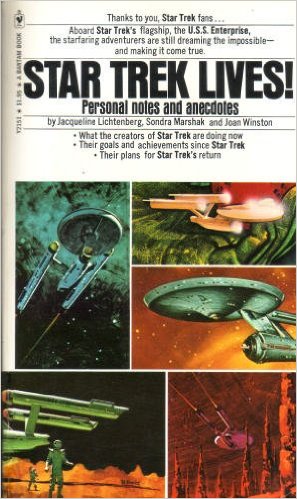Happy 50th Birthday, Star Trek!
Fifty years ago today, Star Trek came into the world, airing its first episode, “The Man Trap.” In the half-century since, it has had an almost unprecedented effect on every aspect of human existence. There are, perhaps, not even words enough to express the power of this little space Western from back when color televisions were a rarity.
On this momentous day, I thought it might be appropriate to look back at the effect Star Trek‘s creators and fans thought it could have – and how it compares to the effect it has had. In 1975, three fans – Joan Winston, Jacqueline Lichtenberg, and Sondra Marshak – published Star Trek Lives!, a momentous piece of fandom history, which gives a fascinating glimpse into the attitudes towards science fiction, Star Trek, and its influence almost fifty years ago.

Available only secondhand on Amazon, but truly a treasure of insights.
In particular, long before the 50th anniversary, Leonard Nimoy suggested the very way in which Star Trek might impact human society: (the following is quoted in Star Trek Lives!)
I think that science fiction has always been not only a bridge between the present and the future, but a scientific-motivator for the future. I think that much of major scientific movement started with science dreamers – somebody who’s dreaming science fiction, what he dreams is s-f. Now he may or may not be a science fiction writer, a dramatist; or he may read science fiction by a science fiction writer that causes him to think about the possibility of accomplishing physically the things the science fiction writer has dreamed about. So obviously a bridge in that sense.
Nimoy mentions something that scientists, science fiction fans, and scholars have long pointed out: that science fiction often not only becomes, but also influences and shapes, science fact, and it would be difficult to find a work of science fiction of which this is more true than Star Trek. It would be impossible to name all of the technologies, all the discoveries and inventions that are due to a fan of Star Trek watching the show and being inspired to try to create its technology or go into the sciences.
This was something that fans of the show recognized less than a decade after it aired. Following Nimoy’s quote, the three fans write:
Since we spoke with Mr. Nimoy, The Smithsonian National Air and Space Museum has begun to collect Star Trek fan-produced material to check out this theory. How many young fans of today will be historically significant scientists of tomorrow? Fifty or a hundred years from now, the Smithsonian may be able to evaluate Star Trek’s impact on modern science.
This quote is serendipitously a-propos: it’s been fifty years, and there are concrete examples and literal answers to the question posed above. In fact, at the recent Star Trek: Mission New York convention that celebrated Star Trek‘s 50th anniversary, one of the absolute best, most inspiring, and most breathtaking events was a panel of four NASA astronauts, engineers, and scientists:
Kjell Lindgren, NASA Astronaut
Michelle Taller, Deputy Director of Science Communications
Dave Lavery, Program Executive for Solar System Exploration
Jeffrey Sheehy, Senior Technical Officer
When asked, each of the above admitted that science fiction directly influenced their choice to pursue a career in the STEM fields and explore space. That choice, in turn, helped transform science fiction into science fact, creating the bridge to the future that Leonard Nimoy spoke of. These are people who have been to space, who have worked on the Mars rovers, who have helped us understand the solar system. And they are Trekkies; in fact, while speaking, one of them mentioned James Kirk’s birth date without missing a beat. Their innovations are not, as far as I know, in the Smithsonian (which does, however, currently house the model of the original Enterprise used for filming the show); instead, these innovations – inspired by Star Trek – are literally exploring Mars and discovering the universe beyond our little planet.

The Enterprise on display at the Smithsonian
Roddenberry jokes in the preface to Star Trek Lives that “we suspected there was an intelligent life form out there, and we aimed to use our show to signal some of our thoughts to them.” Perhaps, in a Galaxy Quest-esque way (and the endless number of parodies and adaptations is yet another of Star Trek‘s myriad influences), the waves of Star Trek have indeed reached distant planets with intelligent life. But even if they haven’t, Star Trek‘s impact goes quite literally beyond our planet, perhaps beyond our solar system, and definitely beyond anything anyone could have imagined. So, on a day when we celebrate such a momentous show, I want to end with the words of Gene Roddenberry himself, who recognized the immense power that a story and a set of ideas could have:
That ugly little advertising box we presently call television has an awesome potential for moving the hearts and minds of people. Whatever the reasons for the Star Trek fan phenomenon, its very existence is evidence that television is too powerful a thing to remain much longer the almost exclusive property of purveyors of ales, cakes and ointments.
If television can bend minds and capture imaginations while in its present rather primitive stage of development, what of tomorrow? It seems to me necessary that we begin to use today’s telecommunications marvels to draw all of humanity together in a free exchange of ideas, art and knowledge…or its great mind-bending potential will be used by a powerful few to own and manipulate the rest of us.
Posted on September 8, 2016, in science fiction, Star Trek. Bookmark the permalink. Leave a comment.

Leave a comment
Comments 0